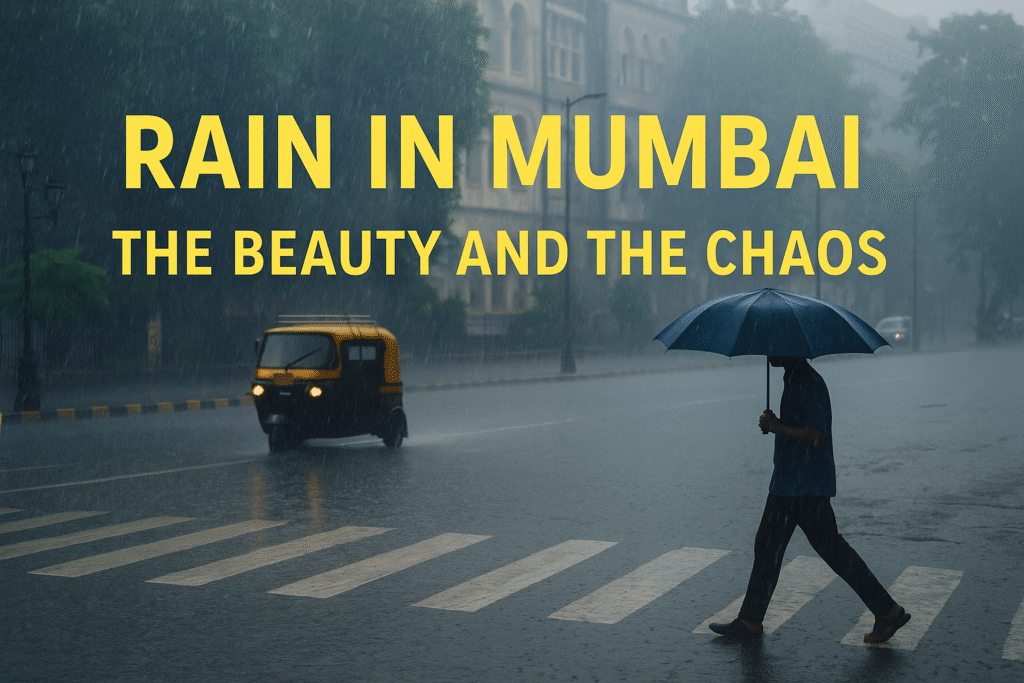
Introduction
Every year, the onset of rain in Mumbai turns the city into a dramatic landscape of contrasts. For some, it’s a romantic escape into cloudy skies and chai-filled evenings. For others, it’s a time of logistical nightmares—flooded roads, delayed trains, and waterlogged homes. This duality makes the monsoon in Mumbai both loved and feared.
In this article, we dive deep into the different facets of Mumbai’s rainy season: its emotional appeal, infrastructural impact, climate data, historical floods, and tips for citizens. Whether you’re a resident or a traveler, understanding rain in Mumbai helps you better navigate the city during its most turbulent months.
The Romance of the Mumbai Monsoon
Why People Love It
Monsoons in Mumbai aren’t just about the weather—they are part of the city’s cultural identity. Walk along Marine Drive after the first showers and you’ll see couples, families, and photographers soaking in the sea breeze and dramatic skies.
Top reasons why people love the Mumbai monsoon:
- Cooling relief from scorching summer heat
- Iconic street food cravings: bhutta (corn), pakoras, vada pav
- Nostalgic associations with school holidays and umbrella rides
- City’s green spaces come alive with lush vegetation
For many, the rain is the backdrop to life in Mumbai, influencing art, literature, and music.
The Chaos Behind the Charm
Despite its aesthetic appeal, Mumbai rains come with serious complications.
Flooding and Waterlogging
Mumbai’s drainage system is often overwhelmed by heavy rain. This leads to waterlogging in major localities such as:
- Dadar
- Andheri
- Sion
- Kurla
- Lower Parel
Table: Annual Rainfall in Mumbai vs. Drainage Capacity
| Year | Total Rainfall (mm) | Drainage Capacity (mm/hr) | Maximum Rainfall in One Day (mm) |
|---|---|---|---|
| 2019 | 3,670 | 25 | 375 |
| 2020 | 3,048 | 25 | 268 |
| 2021 | 3,078 | 25 | 324 |
Despite upgrades in pumping stations, waterlogging remains a recurring issue.
Disrupted Transportation
The lifeline of the city—Mumbai’s suburban train network—often grinds to a halt during the first few days of intense rain. Delays and cancellations lead to packed platforms and frustrated commuters. Roads are no better; potholes and traffic snarls turn a 30-minute drive into a two-hour ordeal.
Health Concerns
Waterborne diseases spike during this period. Common illnesses include:
- Leptospirosis
- Dengue
- Malaria
- Gastroenteritis
Historical Perspective: When Rains Went Too Far
The Flood of 2005
On July 26, 2005, Mumbai recorded an unprecedented 944 mm of rainfall in a single day. The city was paralyzed. Over 1,000 people lost their lives across Maharashtra. Roads turned into rivers, and mobile networks shut down. It exposed how unprepared even a megacity like Mumbai can be when nature strikes.
Recent Incidents
Even in recent years, areas like Hindmata and Milan Subway remain vulnerable. While the BMC has invested in underground water tanks and new pumping stations, execution and maintenance remain questionable.
Sources:
Preparedness and Adaptation
What the Government Is Doing
To mitigate the risks, the Brihanmumbai Municipal Corporation (BMC) has:
- Installed additional pumping stations
- Cleared major nullahs and drains pre-monsoon
- Created emergency control rooms in each ward
- Launched awareness campaigns via social media and SMS
What You Can Do
Monsoon Survival Tips:
- Keep an umbrella and raincoat handy
- Wear waterproof footwear
- Stay updated via apps like MyBMC and Twitter
- Avoid flood-prone routes
- Carry essential medicines and a charged power bank
Best Apps for Rain Updates:
- IMD Weather App
- Skymet Weather
- MyBMC
Rain and Real Estate
Believe it or not, real estate prices in flood-prone zones often stagnate or dip after particularly bad monsoon years. Builders have now started offering flood protection mechanisms in new developments—like raised plinths and advanced drainage systems.
Places to Visit in Mumbai During Monsoon
Not everything about the rain is dreary. If you plan your itinerary wisely, you can enjoy a spectacular side of Mumbai.
Best Monsoon Spots:
- Marine Drive: Perfect for a long walk with the waves crashing in the background
- Sanjay Gandhi National Park: A refreshing forest escape within the city
- Gateway of India: The sea looks majestic during high tide
- Juhu Beach: Enjoy roasted corn with friends and family
Climate Trends and What the Future Holds
Climate change is leading to more erratic rainfall. Some years witness drought-like conditions, while others suffer from flooding.
Key Changes Observed:
- Increasing number of extreme rainfall days
- Uneven distribution of rain over the monsoon season
- Rising sea levels and storm surges during high tides
Scientists and policymakers are calling for a revamp of Mumbai’s monsoon response system. Integrated flood management, better urban planning, and citizen awareness must work hand-in-hand.
Conclusion: Embrace, But Prepare
Rain in Mumbai is an experience—at times magical, at others maddening. It defines the rhythm of the city. The key is not to fear the monsoon, but to be aware, equipped, and respectful of its power.
From taking a stroll down Worli Seaface to avoiding the dreaded Andheri Subway on a rainy evening, surviving Mumbai rains requires common sense, planning, and sometimes, just a good pair of gumboots.
